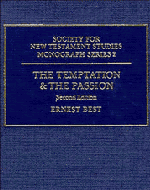Book contents
- Frontmatter
- Contents
- Preface to the First Edition
- Preface to the Second Edition
- List of Abbreviations
- PART I THE TEMPTATION
- PART II THE PASSION
- III The Markan Seams
- IV The Selection of the Material
- V The Order of the Material
- VI The Witness of Jesus and Others to Himself
- VII The Titles of Jesus
- VIII The Christian Community
- IX Conclusion
- Bibliography
- Index of Authors
- Index of Subjects
- Index of Passages Quoted
- Index of Greek Words
V - The Order of the Material
from PART II - THE PASSION
Published online by Cambridge University Press: 28 October 2009
- Frontmatter
- Contents
- Preface to the First Edition
- Preface to the Second Edition
- List of Abbreviations
- PART I THE TEMPTATION
- PART II THE PASSION
- III The Markan Seams
- IV The Selection of the Material
- V The Order of the Material
- VI The Witness of Jesus and Others to Himself
- VII The Titles of Jesus
- VIII The Christian Community
- IX Conclusion
- Bibliography
- Index of Authors
- Index of Subjects
- Index of Passages Quoted
- Index of Greek Words
Summary
We turn now to the order in which Mark has put together the material he has selected. It must be realised that Mark was not completely master of the situation. The story of the Passion could not be put at any other point than at the end of his book; likewise the account of John's preaching and baptism of Jesus must come at the beginning. Between these two fixed points it is a matter of conjecture how far genuine biographical considerations ordered the material. Mark's plan of the ministry in which Jesus does not appear in Jerusalem until the last few days would not appear to be borne out by the evidence from the other Gospels. But if Mark has decided that there is only one short period of ministry in Jerusalem then all the material concerned with Jerusalem must appear at that point. There is another way in which Mark may not have been fully master of the order of his material. Whereas some of it may have come to him as individual pericopae which he was free to insert where he wished, some of it also came to him as complexes (i. 16–39 or ii. i–iii. 5) either in, or aprt from, written sources and he appears to have kept together at least some of the material that came to him in this way; at any rate, if he did not, then it would be impossible today to detect the pre-Markan complexes.
The most striking feature of the Markan arrangement is the disproportionate amount of space given to the death of Jesus. This dominates the whole Gospel, being indeed a case of the tail wagging the dog.
- Type
- Chapter
- Information
- The Temptation and the PassionThe Markan Soteriology, pp. 112 - 133Publisher: Cambridge University PressPrint publication year: 1990



